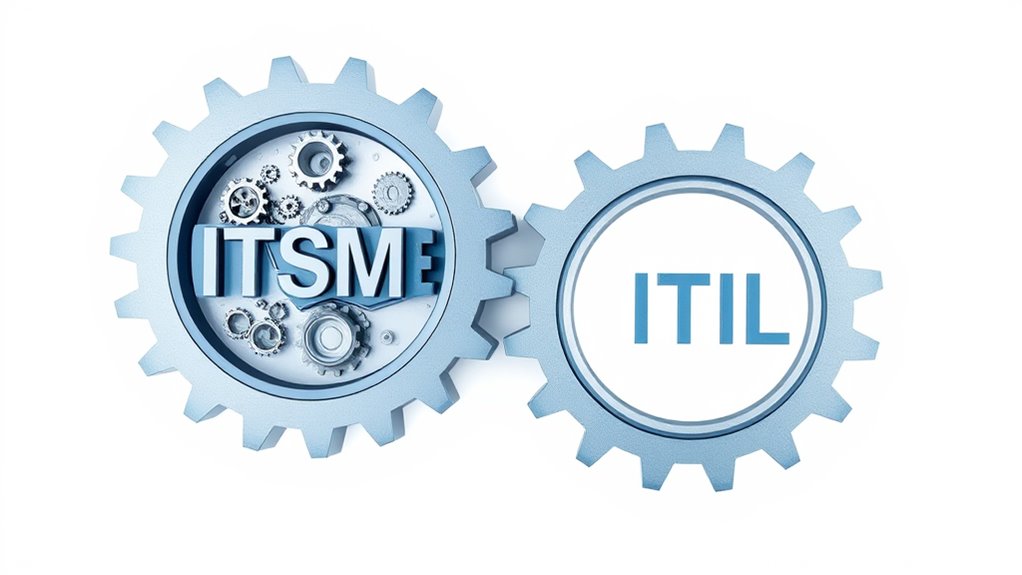IT Service Management streamlines technology operations in modern businesses through structured frameworks like ITIL. Organizations implement key processes including incident management, service requests, and change control to maintain service quality. ITSM utilizes cloud solutions, automation, and self-service portals to enhance efficiency while aligning IT capabilities with business objectives. Through continuous monitoring and improvement cycles, ITSM guarantees peak service delivery and positions businesses to access greater technological value.

Modern businesses increasingly rely on IT Service Management (ITSM) to streamline their technology operations and deliver value to customers. ITSM frameworks, particularly ITIL, provide structured approaches to managing IT services throughout their entire lifecycle. Organizations implement these frameworks to align their IT capabilities with business objectives while maintaining service quality and operational efficiency. Creating a proactive problem-solving culture helps prevent future service disruptions and enhances operational stability. Knowledge management plays a vital role in capturing and sharing critical information to enhance service delivery across the organization.
The ITSM lifecycle encompasses five essential stages that work together seamlessly. Service Strategy establishes the foundation by aligning IT services with business goals and managing the service portfolio. Service Design and Shift phases guarantee new services are properly developed, tested, and implemented. Service Operation handles day-to-day delivery and support, while Continual Service Improvement utilizes performance data to enhance services consistently. Implementing service quality standards helps organizations maintain high customer satisfaction levels.
Core ITSM processes form the backbone of effective IT service delivery. Incident Management rapidly addresses service disruptions, while Service Request Management efficiently fulfills user needs for resources like software installations or password resets. Change Management controls updates and modifications to IT systems, reducing risks and service interruptions. Asset and Configuration Management maintain accurate records of IT resources, guaranteeing peak utilization and control.
Technology plays an essential role in modern ITSM implementation. Cloud-based solutions provide scalability and accessibility for remote work environments, while automation reduces manual errors and accelerates service delivery. Self-service portals and knowledge bases empower users to resolve common issues independently, decreasing support desk workload and improving satisfaction.
ITSM’s strategic value extends beyond operational efficiency. Financial management within ITSM guarantees cost-effective service delivery, while demand management maximizes resource allocation based on usage forecasts. Service Level Agreements (SLAs) establish clear expectations for service quality and response times.
The integration of ITSM with business strategy enables organizations to leverage IT capabilities for competitive advantage while maintaining regulatory compliance and managing risks effectively. Through continuous feedback loops and performance monitoring, organizations can adapt their IT services to evolving business needs and technological advances.
Frequently Asked Questions
What Certifications Are Required to Become an IT Service Management Professional?
IT service management professionals typically start with ITIL 4 Foundation certification, which provides essential ITSM concepts and principles.
Advanced practitioners pursue ITIL Managing Professional (MP) or Strategic Leader (SL) certifications.
Additional valuable certifications include ISO/IEC 20000 for international standards compliance, COBIT for IT governance expertise, and specialized certificates like Certified IT Manager (CITM) for thorough management skills.
Organizations often require a combination of these certifications based on specific role requirements.
How Long Does It Take to Implement ITSM Frameworks in Small Businesses?
ITSM implementation for small businesses typically takes 6-12 months, depending on organizational complexity and available resources.
The process follows distinct phases: assessment (2-3 months), core implementation of incident management and ticketing systems (3-4 months), and optimization (2-3 months).
Success factors include proper resource allocation, staff training readiness, and effective change management practices.
A phased approach helps manage workload while ensuring sustainable adoption.
Can ITSM Tools Integrate With Legacy Systems Already in Place?
ITSM tools can effectively integrate with legacy systems through various technical approaches.
Modern integration methods include middleware solutions, API-based connections, and RPA implementations.
While integration challenges exist due to outdated platforms and compatibility issues, organizations can overcome these through careful assessment and strategic implementation.
Solutions like Enterprise Service Bus (ESB) and iPaaS platforms enable seamless data exchange while preserving existing system investments and maintaining business continuity.
What Is the Average Cost of ITSM Software for Enterprise-Level Organizations?
Enterprise-level ITSM software costs typically range from $50 to $100+ per user per month, with prices varying based on deployment options and feature sets.
High-end solutions like BMC Helix charge approximately $114.75 per named user monthly, while concurrent licenses start at $275+.
Total costs depend on:
- Number of users/agents
- Selected features and modules
- Support level requirements
- Integration needs
- Deployment method (cloud vs. on-premises)
How Often Should Companies Update Their ITSM Processes and Methodologies?
Companies should review ITSM processes annually at minimum, with quarterly assessments recommended for organizations in rapidly evolving technological environments.
Updates should occur when triggered by:
- Significant organizational changes
- New technology implementations
- Persistent service issues
- Regulatory requirement changes
- User feedback and performance metrics
Dynamic businesses often implement continuous improvement approaches, making incremental updates as inefficiencies are identified rather than waiting for scheduled reviews.









